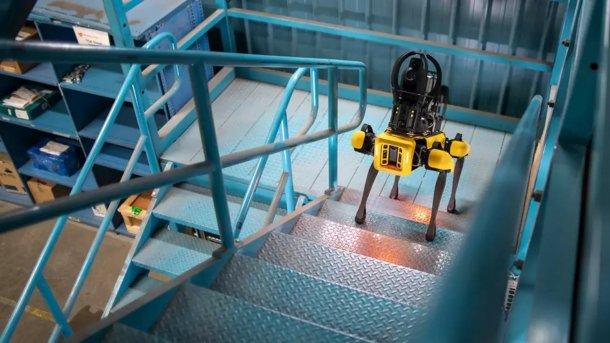Robots can walk worse than animals – despite technical superiority
Robots with legs can sometimes walk more, sometimes less well. But they never come close to the performance of animals. Why is that?

Robot dog Spot is a good and safe runner. But he can't run as elegantly and safely as an animal.
(Bild: Boston Dynamics)
An interdisciplinary team of scientists and engineers from various universities has investigated the question of why robots do not currently have at least the same walking abilities as animals. Although the researchers consider most subsystems of robots to be superior to those of animals, robots still run slower and less safely.
In the study "Why animals can outrun robots", which was published in Science Robotics, the scientists examined various aspects of walking robots and compared them with those of animals. The researchers examined five subsystems that are crucial for a running robot. According to the scientists, these are drive, frame (i.e. body), actuation, sensors and control. The researchers compared these subsystems with the corresponding biological equivalents of animals. The original assumption was that the superiority of animals was based on the superiority of their individual biological components. However, the scientists were able to disprove this. They proved that the biological components performed worse in comparison than the artificial ones.
"It turned out that, with only a few exceptions, the technical subsystems outperform the biological equivalents, sometimes even radically," says Tom Libby, senior research engineer at the Stanford Research Institute at Stanford University. "But it's also clear that when you compare animals to robots at the whole system level, the animals are wonderful in terms of movement. And the robots still have some catching up to do."
Better integration needed
The researchers believe that the key to the existing superiority of animals in walking lies primarily in the integration and interaction of the individual components and their control. In the case of robots, they are not yet at a level that is sufficient to beat animals in their walking abilities. However, progress in robotics has been remarkably fast. If you compare this with the many millions of years of development of animals, this is a fantastic achievement. However, this is mainly because evolution is undirected.
"While we can very well correct the development of robots and learn something with one robot and then transfer it to any other robot, biology does not have this option. So there are ways in which we can progress much faster in the development of robots than through evolution – but evolution has a huge head start."
The scientists hope that their research can help to focus future robot development work on not just trying to build better hardware. Instead, developers should focus their efforts on understanding how existing hardware components can be better integrated and controlled.
(olb)